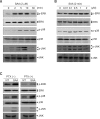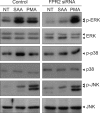A pertussis toxin sensitive G-protein-independent pathway is involved in serum amyloid A-induced formyl peptide receptor 2-mediated CCL2 production
- PMID: 20177146
- PMCID: PMC2859329
- DOI: 10.3858/emm.2010.42.4.029
A pertussis toxin sensitive G-protein-independent pathway is involved in serum amyloid A-induced formyl peptide receptor 2-mediated CCL2 production
Abstract
Serum amyloid A (SAA) induced CCL2 production via a pertussis toxin (PTX)-insensitive pathway in human umbilical vein endothelial cells (HUVECs). SAA induced the activation of three MAPKs (ERK, p38 MAPK, and JNK), which were completely inhibited by knock-down of formyl peptide receptor 2 (FPR2). Inhibition of p38 MAPK and JNK by their specific inhibitors (SB203580 and SP600125), or inhibition by a dominant negative mutant of p38 MAPK dramatically decreased SAA-induced CCL2 production. Inactivation of G((i)) protein(s) by PTX inhibited the activation of SAA-induced ERK, but not p38 MAPK or JNK. The results indicate that SAA stimulates FPR2-mediated activation of p38 MAPK and JNK, which are independent of a PTX-sensitive G-protein and are essential for SAA-induced CCL2 production.
Figures





Similar articles
-
Activation of formyl peptide receptor like-1 by serum amyloid A induces CCL2 production in human umbilical vein endothelial cells.Biochem Biophys Res Commun. 2009 Mar 6;380(2):313-7. doi: 10.1016/j.bbrc.2009.01.068. Epub 2009 Jan 22. Biochem Biophys Res Commun. 2009. PMID: 19167353
-
Serum amyloid A induces WISH cell apoptosis.Acta Pharmacol Sin. 2007 Jan;28(1):73-80. doi: 10.1111/j.1745-7254.2007.00475.x. Acta Pharmacol Sin. 2007. PMID: 17184585
-
Sphingosylphosphorylcholine stimulates CCL2 production from human umbilical vein endothelial cells.J Immunol. 2011 Apr 1;186(7):4347-53. doi: 10.4049/jimmunol.1002068. Epub 2011 Mar 2. J Immunol. 2011. PMID: 21368227
-
Acute-serum amyloid A and A-SAA-derived peptides as formyl peptide receptor (FPR) 2 ligands.Front Endocrinol (Lausanne). 2023 Feb 3;14:1119227. doi: 10.3389/fendo.2023.1119227. eCollection 2023. Front Endocrinol (Lausanne). 2023. PMID: 36817589 Free PMC article. Review.
-
Serum amyloid A: an acute-phase protein involved in tumour pathogenesis.Cell Mol Life Sci. 2009 Jan;66(1):9-26. doi: 10.1007/s00018-008-8321-x. Cell Mol Life Sci. 2009. PMID: 18726069 Free PMC article. Review.
Cited by
-
G(i/o) protein-dependent and -independent actions of Pertussis Toxin (PTX).Toxins (Basel). 2011 Jul;3(7):884-99. doi: 10.3390/toxins3070884. Epub 2011 Jul 15. Toxins (Basel). 2011. PMID: 22069745 Free PMC article. Review.
-
Functional Interactions Between Recombinant Serum Amyloid A1 (SAA1) and Chemokines in Leukocyte Recruitment.Int J Mol Sci. 2025 Mar 3;26(5):2258. doi: 10.3390/ijms26052258. Int J Mol Sci. 2025. PMID: 40076881 Free PMC article. Review.
-
Distinct signaling cascades elicited by different formyl peptide receptor 2 (FPR2) agonists.Int J Mol Sci. 2013 Apr 2;14(4):7193-230. doi: 10.3390/ijms14047193. Int J Mol Sci. 2013. PMID: 23549262 Free PMC article. Review.
-
Role of Serum Amyloid A in Abdominal Aortic Aneurysm and Related Cardiovascular Diseases.Biomolecules. 2021 Dec 15;11(12):1883. doi: 10.3390/biom11121883. Biomolecules. 2021. PMID: 34944527 Free PMC article. Review.
-
Serum amyloid A is a growth factor for 3T3-L1 adipocytes, inhibits differentiation and promotes insulin resistance.Int J Obes (Lond). 2012 Aug;36(8):1032-9. doi: 10.1038/ijo.2011.193. Epub 2011 Oct 11. Int J Obes (Lond). 2012. PMID: 21986708 Free PMC article.
References
-
- Badolato R, Johnston JA, Wang JM, McVicar D, Xu LL, Oppenheim JJ, Kelvin DJ. Serum amyloid A induces calcium mobilization and chemotaxis of human monocytes by activating a pertussis toxin-sensitive signaling pathway. J Immunol. 1995;155:4004–4010. - PubMed
-
- Baranova IN, Vishnyakova TG, Bocharov AV, Kurlander R, Chen Z, Kimelman ML, Remaley AT, Csako G, Thomas F, Eggerman TL, Patterson AP. Serum amyloid A binding to CLA-1 (CD36 and LIMPII analogous-1) mediates serum amyloid A protein-induced activation of ERK1/2 and p38 mitogen-activated protein kinases. J Biol Chem. 2005;280:8031–8040. - PubMed
-
- Björkman L, Karlsson J, Karlsson A, Rabiet MJ, Boulay F, Fu H, Bylund J, Dahlgren C. Serum amyloid A mediates human neutrophil production of reactive oxygen species through a receptor independent of formyl peptide receptor like-1. J Leukoc Biol. 2008;83:245–253. - PubMed
-
- Cai L, de Beer MC, de Beer FC, van der Westhuyzen DR. Serum amyloid A is a ligand for scavenger receptor class B type I and inhibits high density lipoprotein binding and selective lipid uptake. J Biol Chem. 2005;280:2954–2961. - PubMed
Publication types
MeSH terms
Substances
LinkOut - more resources
Full Text Sources
Research Materials
Miscellaneous
